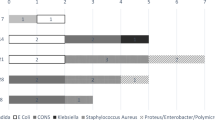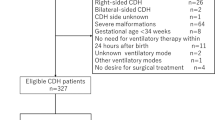Abstract
BACKGROUND: Congenital diaphragmatic hernia (CDH) is often associated with severe pulmonary hypoplasia resulting in hypoxemic respiratory failure unresponsive to advanced medical management including the use of inhaled nitric oxide (iNO). For these patients, extracorporeal membrane oxygenation (ECMO) serves as the last potentially effective treatment choice. Since the efficacy of iNO in this patient population is not known and since most neonatal intensive care units using iNO for the treatment of these critically ill neonates do not provide ECMO, the ability to more accurately predict which patient is at risk for failing medical management with iNO and requires a timely transfer to an ECMO center can be life saving. Therefore, in this study, we sought to determine the risk factors for the need for ECMO in a cohort of 27 neonates with isolated left CDH and hypoxemic respiratory failure treated with iNO.
STUDY DESIGN: In this retrospective study, 27 patients with left CDH were identified during a 2-year period. During the study period, strict clinical guidelines had been used to standardize iNO therapy, to provide adequate lung inflation and cardiovascular support, and to recognize treatment failures and the need for ECMO. Logistic regression analysis was used to study the relationship between the need for ECMO and a set of suspected risk factors.
RESULTS: When subjected to logistic regression analysis, only the presence of a pneumothorax remained significantly associated with the need for ECMO (OR=22; 95% CI=2.18 to 222), while none of the other variables examined such as mean airway pressure, FiO2, PaO2, or PaCO2 were predictors for the need of ECMO after 6 hours of treatment with iNO.
CONCLUSION: These data indicate that a prompt transfer to an ECMO center should be initiated for hypoxemic patients with CDH receiving medical management with iNO if they develop an air leak syndrome.
This is a preview of subscription content, access via your institution
Access options
Subscribe to this journal
Receive 12 print issues and online access
$259.00 per year
only $21.58 per issue
Buy this article
- Purchase on Springer Link
- Instant access to full article PDF
Prices may be subject to local taxes which are calculated during checkout

Similar content being viewed by others
References
Azarow K, Messineo A, Pearl R, Filler R, Barker G, Bohn D . Congenital diaphragmatic hernia — a tale of two cities: the Toronto experience. J Pediatr Surg 1997;32:395–400.
Semakula N, Stewart DL, Goldsmith LJ, Cook LN, Bond SJ . Survival of patients with congenital diaphragmatic hernia during the ECMO era: an 11-year experience. J Pediatr Surg 1997;32:1683–1689.
Wilson JM, Lund DP, Lillehei CW, Vacanti JP . Congenital diaphragmatic hernia - a tale of two cities: the Boston experience. J Pediatr Sur 1997;32:401–405.
Clark RH, Hardin Jr WD, Hirschl RB, et al. The Congenital Diaphragmatic Hernia Study Group. Current surgical management of congenital diaphragmatic hernia: a report from the CDH Study Group. J Pediatr Surg 1998;33:1004–1009.
Sreenan C, Etches P, Osiovich H . The western Canadian experience with congenital diaphragmatic hernia: perinatal factors predictive of extracorporeal membrane oxygenation and death. Pediatr Surg Int 2001;17:196–200.
Boloker J, Bateman DA, Wung JT, Stolar CJ . Congenital diaphragmatic hernia in 120 infants treated conservatively with permissive hypercapnia/spontaneous respirations/elective repair. J Pediatr Surg 2002;37:357–366.
Stevens TP, Chess PR, McConnochie KM, et al. Survival in early and late term infants with congenital diaphragmatic hernia treated with extracorporeal membrane oxygenation. Pediatrics 2002;110:590–596.
Neonatal Inhaled Nitric Oxide Study Group (NINOS). Inhaled nitric oxide and hypoxic respiratory failure in infants with congenital diaphragmatic hernia. Pediatrics 1997;99:838–845.
Nagaya M, Kato J, Niimi N, Tanaka S, Tanaka T . Analysis of patients with congenital diaphragmatic hernia requiring pre-operative extracorporeal membrane oxygenation (ECMO). Pediatr Surg Int 1998;14:25–29.
Keshen TH, Gursoy M, Shew SB, et al. Does extracorporeal membrane oxygenation benefit neonates with congenital diaphragmatic hernia? Application of a predictive equation. J Pediatr Surg 1997;32:818–822.
Neonatal Inhaled Nitric Oxide Study Group. Inhaled nitric oxide in full term and nearly full term infants with hypoxic respiratory failure. N Engl J Med 1997;336:597–604.
Clark RH, Kueser TJ, Walker MW, et al. Low-dose nitric oxide therapy for persistent pulmonary hypertension of the newborn. N Engl J Med 2000;342:469–474.
Roberts Jr JD, Polaner DM, Lang P, Zapol WM . Inhaled nitric oxide in persistent pulmonary hypertension of the newborn. Lancet 1992;340:818–819.
Kinsella JP, Neish SR, Shaffer E, Abman SH . Low-dose inhalational nitric oxide in persistent pulmonary hypertension of the newborn. Lancet 1992;340:819–820.
Kinsella JP, Neish SR, Dunbar I, Shaffer E, Abman SH . Clinical responses to prolonged treatment of persistent pulmonary hypertension of the newborn with low doses of inhaled nitric oxide. J Pediatr 1993;123:103–108.
Author information
Authors and Affiliations
Rights and permissions
About this article
Cite this article
Sebald, M., Friedlich, P., Burns, C. et al. Risk of Need for Extracorporeal Membrane Oxygenation Support in Neonates with Congenital Diaphragmatic Hernia Treated with Inhaled Nitric Oxide. J Perinatol 24, 143–146 (2004). https://doi.org/10.1038/sj.jp.7211033
Published:
Issue Date:
DOI: https://doi.org/10.1038/sj.jp.7211033
This article is cited by
-
Initial Oxygenation Response to Inhaled Nitric Oxide Predicts Improved Outcome in Congenital Diaphragmatic Hernia
Drugs in R&D (2014)
-
Neonatologische Notfälle beim reifen Neugeborenen
Intensivmedizin und Notfallmedizin (2011)



